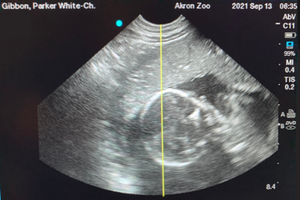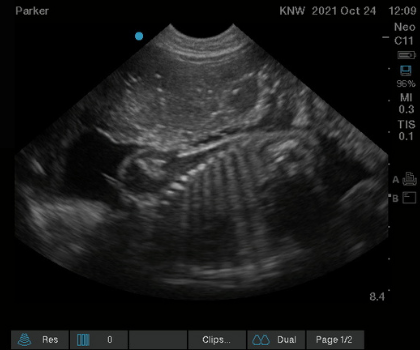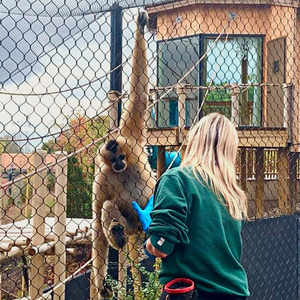Each October, medical professionals celebrate Medical Ultrasound Awareness Month. When we hear the word “ultrasound,” our first thought isn’t usually of the zoo, but ultrasounds actually have a wide variety of uses in healthcare, both for people and animals!
 Earlier this year, the Robert O. & Annamae Orr Family Foundation donated a new ultrasound machine to the Akron Zoo’s veterinary hospital. Ultrasound imaging, which uses sound waves to produce pictures of the inside of the body, helps our vet staff diagnose problems with internal organs and soft tissue of animals, as well as track animal pregnancies. The new technology will provide more accurate readings and improve our veterinary staff’s ability to provide top notch care for our more than 1,000 Akron Zoo residents of all shapes and sizes.
Earlier this year, the Robert O. & Annamae Orr Family Foundation donated a new ultrasound machine to the Akron Zoo’s veterinary hospital. Ultrasound imaging, which uses sound waves to produce pictures of the inside of the body, helps our vet staff diagnose problems with internal organs and soft tissue of animals, as well as track animal pregnancies. The new technology will provide more accurate readings and improve our veterinary staff’s ability to provide top notch care for our more than 1,000 Akron Zoo residents of all shapes and sizes.
Our keepers and vet staff work together on many healthcare-focused trainings for our animals, including trainings to participate in ultrasounds. Like every training at the Akron Zoo, ultrasound training is completely voluntary, meaning animals can choose whether or not to participate. That being said, keepers do incentivize participation with some of the animal’s favorite treats. Over time, repeated trainings help to build trust and make the animal more comfortable participating. 
One of the first animals to take our new ultrasound machine for a test drive was Parker, our female white-cheeked gibbon. Parker is expecting her first baby in December, so it is important that we are able to give her regular ultrasounds to track the baby’s health and development.
Parker had not had any ultrasound training prior to her arrival at the Akron Zoo, and she had very little training with other advanced behaviors, so lead gibbon keeper Brenna Erjavec knew she had her work cut out for her. She decided to break down ultrasound training into three stages: belly present, belly palpate, and ultrasound.
First, Parker was trained to present her belly to keepers. Keepers use the cue word “belly” and make a specific hand signal to ask Parker to push her belly closer to the training port – essentially a little door that opens to a larger space for training. Keepers use a clicker and a verbal “good” or “yes” to let Parker know that she is correctly doing what the keeper asked. Parker is also rewarded for participating in the training, usually with a treat such as fruit or honey.
 Once Parker was comfortable completing this behavior in an area that was ideal for vet staff, and she could hold it for at least 15 seconds, keepers added the belly palpate step. Once in position, keepers use the cue “rub” to let Parker know that they will be gently rubbing and pushing into her belly. Once again, keepers use verbal cues and the clicker to let Parker know that she has gotten the behavior correct, and Parker receives treats for completing the behavior. After about two months of learning these behaviors and becoming comfortable with them, it was time for the first ultrasound!
Once Parker was comfortable completing this behavior in an area that was ideal for vet staff, and she could hold it for at least 15 seconds, keepers added the belly palpate step. Once in position, keepers use the cue “rub” to let Parker know that they will be gently rubbing and pushing into her belly. Once again, keepers use verbal cues and the clicker to let Parker know that she has gotten the behavior correct, and Parker receives treats for completing the behavior. After about two months of learning these behaviors and becoming comfortable with them, it was time for the first ultrasound!
“Establishing the trust needed to train Parker has been extremely rewarding, I think even more so because she really makes you earn it,” says lead gibbon keeper, Brenna Erjavec. “When she quickly performs tasks or behaviors, it's because I know she truly wants to participate with me, not just earn a treat. It's a relationship built on mutual respect, and that's kind of the best-case-scenario I can think of for training an animal in my care.”
Parker has now voluntarily participated in several ultrasounds, and each time the baby appeared healthy and on track for his or her due date. We are all very excited for this new arrival, and for the exceptional care the Akron Zoo will be able to continue to provide for all of our animals.
